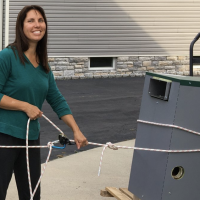single zone hot water baseboard heat... how to reduce heat in "first" room of the series?
Hi,
I actually brought this up a few years back and for a while it seemed like just closing the small vents on the baseboard helped, but not really (maybe I'm just getting older and more sensetive to the heat)…
Anyway, my burner and pump are in the garage and the first room that sees the "new" heat is my bedroom. Is there a way to reduce the heat output in one room without adding a zone? Seems to me a dual-piped baseboard (one pipe finned and one insulated) that has a thermostat that controls the path would do the trick. Is there such a thing or is there some other way to do it?
Thanks for any thoughts…
Comments
-
That would be a pretty complicated solution not to mention expensive. Closing the lover on the convector does work sometimes. Another way to stop convection is to cover the aluminum fins with tin foil. Pull of a sheet and cover the front back and top on the fins inside the metal covers.
Miss Hall's School service mechanic, greenhouse manager, teacher, dog walker and designated driver
1 -
Yea, I agree not a cheap solution; but certainly cheaper than it would be to run another zone. I'm kinda surprised something like this isn't available for those willing to pay for it.
I may have to try what you suggest…
Thanks,
0 -
I wouldn't think of it as a hack or last resort, nor would I have any hesitation in implementing a similar solution. Reducing the convection of the too-hot-for-the-room is a perfect solution. It corrects the mis-sizing that someone apparently did when they initially installed it.
NJ Steam Homeowner.
Free NJ and remote steam advice: https://heatinghelp.com/find-a-contractor/detail/new-jersey-steam-help/
See my sight glass boiler videos: https://bit.ly/3sZW1el0 -
You certainly could tee of the supply and return of you baseboard and install a thermostatic valve of some type, either a nonelectric actuator or a conventional zone valve operated through a transformer and a thermostat. This is a somewhat common way to zone individual rooms remote of the boiler room. it can make future service somewhat cumbersome especially if there are a number of these zones spread around a building.
Miss Hall's School service mechanic, greenhouse manager, teacher, dog walker and designated driver
0 -
Thinking about it, I have some leftover garage door insulation that may just be a perfect solution for this.
Thanks for the comments. I really appreciate this forum!
0 -
This has actually been thought of over 50 years ago. On page 21 of this book, Zoning Made Easy I use for teaching a one day seminar on Hydronic heating, is the explanation and a diagram of how to "Zone" a series loop with a bypass. In this case they used 1/2" pipe for the bypass but if you need the full flow of a 3/4" pipe, that is certainly an option. By adding insulation to the bypass pipe you ensure that the least amount of heat is allowed out of the convector cover of the baseboard. But too much insulation can be a blockage for the needed air flow what heat is supposed to flow, So use a mininum of insulation there. There are several ways to add the zone valve. Using the Thermostatic Radiator Valve (TRV) that requires no electric connection works well for the room that overheats by stopping heating in the hot room’s radiator. In order to get heat in that room there must be a call for heat from that loop, however when that room reaches the desired temperature set by the TRV, the valve closes and the room stops getting heat while the rest of the zone is allowed to heat based on the call for heat from the thermostat.
Although B&G no longer markets the Thermomate® TRV, there are other companies, like Danfoss and Resideo (Formerly Honeywell) that do offer the TRV you can use for this project. And it will be somewhat less expensive that adding a separate zone with the electrical controls and home run piping to the boiler room that is associates with it.
You just need to find a plumber that can understand what is needed and is willing to do it.
Edward Young Retired
After you make that expensive repair and you still have the same problem, What will you check next?
0 -
When your only tool is a hammer, every problem looks like a nail. When your only tool is pipe, every problem looks like…?
NJ Steam Homeowner.
Free NJ and remote steam advice: https://heatinghelp.com/find-a-contractor/detail/new-jersey-steam-help/
See my sight glass boiler videos: https://bit.ly/3sZW1el0 -
-
The challenge is understanding both the problem and the customers expectations. So is the bedroom 76 when the rest of the house is 70? If so do you want the bedroom 70, or cooler? Or is the bedroom 70 when the rest of the house is 70 and you want it cooler? Then what is the expectation? The right answer could be smaller baseboard, insulating existing baseboard, a bypass on the one baseboard or a whole new zone. All have pros and cons.
0 -
If closing the damper and/or covering the fins doesn’t work, you could simply start removing the fins until you get the output where you like it. A pair of tin snips to slice them and needle nose pliers are all that’s needed.
Of course, that’s a one way street that you can’t go back on, so be careful how much you remove.
Bob Boan
You can choose to do what you want, but you cannot choose the consequences.2 -
I had a bad thermostat wire in a fully finish house . I installed a wireless for nice old lady . We were unsure of the best room to mount it so I left with the understanding she would get back to me on where to mount it .. He kept it by Her side for years :) still dose God willing .
There was an error rendering this rich post.
1 -
@EdTheHeaterMan that modified loop system is almost exactly what I was thinking of; however, I was hoping that some company had a baseboard with all that built in (parallel pipes and connection to control the valve). The nice thing about that is the bypass is still in the heated room (instead of under the floor), so less heat would be lost; plus of course, just having it all in one unit would be easier to install.
I have to think about this… I will probably start (as I mentioned above) by just wrapping a portion of the pipe with insulation. Maybe also do what @Ironman suggested and remove some of the tin. Then if it doesn't work next year (spring is on the way, so I won't really be able to test it till next winter) I may just bite the bullet and try the whole bypass setup; but I think I would attempt to build it all into the baseboard.
@EdTheHeaterMan, one thing that bothers me about the modified loop system is how do you know you've removed all the air from the system? I know bleeders can be put at the far end of the section but that only works for the top pipe right?
Thanks again to all for the comments!
0 -
-
Yeah I can't imagine adding a bunch of pipe and fittings when reducing convection will do exactly what you want.
NJ Steam Homeowner.
Free NJ and remote steam advice: https://heatinghelp.com/find-a-contractor/detail/new-jersey-steam-help/
See my sight glass boiler videos: https://bit.ly/3sZW1el1 -
-
When you guys say "foil" are you literally referring to kitchen type aluminum foil or is there something specifically used for this application?
0 -
Just regular foil…anything that would reduce air flow through the fins. You could use aluminum tape also or really lots of things. Not much is going to melt at 180F
NJ Steam Homeowner.
Free NJ and remote steam advice: https://heatinghelp.com/find-a-contractor/detail/new-jersey-steam-help/
See my sight glass boiler videos: https://bit.ly/3sZW1el1 -
The fin tube heats the air via convection, no air passes through then there is no convection, If it were me I would use the regular old aluminum foil in my kitchen to get the job done. This way you are not adding any parts that can fail, and you can adjust it until its about right, I'm assuming if you lived with it for this long you aren't super picky about the exact temp. If you want a thermostat to control your zone then the repipe proposed above would be your best bet, just please leave a note in the mechanical room or something indicating that you have a control valve buried somewhere, it creates confusion when these things are not clear to service techs, may as well leave a not about the foil as well for any future owners.
0 -
i would use household foil, it will hold itself on, i wouldn't want to get tape adhesive all over it
0 -
Thanks again for all the comments and feedback. I'm gonna stick with using the foil as the first attempt. As many of you have already said, it will probably be all I need. Unfortunately we won't know how well it works out till next Winter 'cause by the time I do this I'll be turning off the heat for the season.
0 -
That's what I would have thought here in Michigan but that hasn't been a problem the past week or so.
0
Categories
- All Categories
- 87.3K THE MAIN WALL
- 3.2K A-C, Heat Pumps & Refrigeration
- 61 Biomass
- 429 Carbon Monoxide Awareness
- 120 Chimneys & Flues
- 2.1K Domestic Hot Water
- 5.8K Gas Heating
- 114 Geothermal
- 166 Indoor-Air Quality
- 3.7K Oil Heating
- 77 Pipe Deterioration
- 1K Plumbing
- 6.5K Radiant Heating
- 395 Solar
- 15.7K Strictly Steam
- 3.4K Thermostats and Controls
- 56 Water Quality
- 51 Industry Classes
- 50 Job Opportunities
- 18 Recall Announcements






